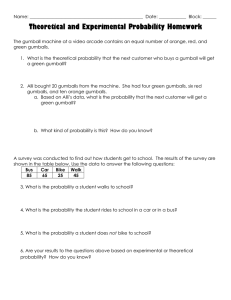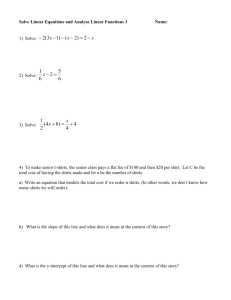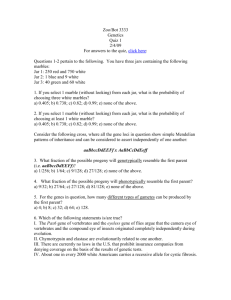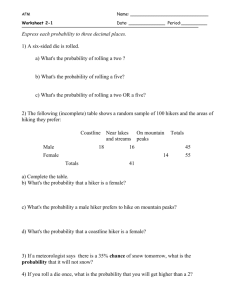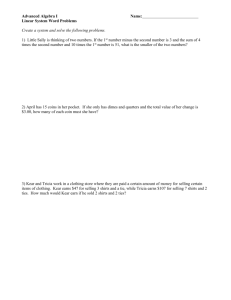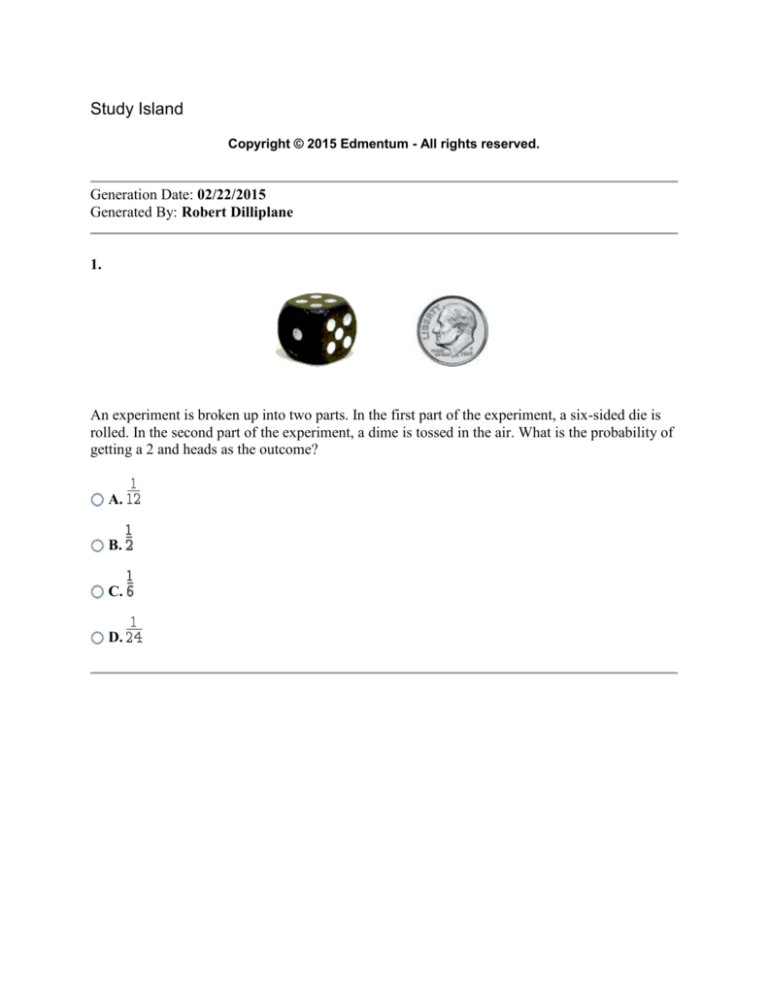
Study Island
Copyright © 2015 Edmentum - All rights reserved.
Generation Date: 02/22/2015
Generated By: Robert Dilliplane
1.
An experiment is broken up into two parts. In the first part of the experiment, a six-sided die is
rolled. In the second part of the experiment, a dime is tossed in the air. What is the probability of
getting a 2 and heads as the outcome?
A.
B.
C.
D.
2. In an experiment a six-sided die is rolled a number of times. The results are shown below.
Number Rolled Number of Times Rolled
1
6
2
4
3
8
4
3
5
3
6
3
Based on these results, what is the experimental probability of rolling either a 5 or 6?
A. 2/9
B. 7/27
C. 2/7
D. 1/9
3. Audrey has a bag of similar-sized red and green grapes. There are 12 red grapes and 13 green
grapes in the bag. If the first 7 grapes she ate were green what is the probability that the 8th
grapes she eats is green and the 9th grape she eats is red?
A.
B.
C.
D.
4. In a group of 294 students, 130 are seniors and 121 are males. Exactly one-half of seniors are
females. If a student is randomly selected, what is the probability that the student is a senior or a
female?
A.
B.
C.
D.
5. There are two jars. One jar has 2 orange marbles and 3 red marbles. The other jar has 1 blue
marble and 4 green marbles. If Jeff randomly draws one marble from each jar, what is the
probability that he will draw a red marble and a green marble?
A.
B.
C.
D.
6. Sam's closet contains blue and green shirts. He has eight blue shirts, and seven green shirts.
Five of the blue shirts have stripes, and four of the green shirts have stripes. What is the
probability that Sam randomly chooses a shirt that is blue or has stripes?
A.
B.
C.
D.
7. Courtney and Alan are conducting an experiment. Every time Courtney flips a fair two-sided
coin, Alan rolls a six-sided die. What is the probability that the coin will land on heads and the
die will land on 2?
A.
B.
C.
D.
8. Chris has a bag of four apples. Three of the apples are red and one of them is green. He also
has a bag with two sandwiches. One of the sandwiches is ham and the other is turkey. If he
reaches into both bags without looking, what is the probability that he will grab a green apple
and a ham sandwich?
A.
B.
C.
D.
9. Kayla has a standard deck of 52 cards and a six-sided die. What is the probability that she will
pull a diamond from the deck of cards and roll a 2?
A.
B.
C.
D.
10.
An experiment consists of rolling two fair dice and adding the dots on the two sides facing up.
What is the probability that the sum of the dots is 7 or 11?
A.
B.
C.
D.
11. There are two jars. One jar contains 2 red gumballs, 3 green gumballs, and 1 yellow gumball.
The other jar contains 2 blue balloons and 3 purple balloons. Jeff randomly draws one gumball
and then one balloon. What is the probability that he will draw a red gumball and a purple
balloon?
A.
B.
C.
D.
12. Gary has 1 red apple, 1 green apple, and 4 yellow apples in a sack. He also has 2 packages of
peanuts, 2 packages of almonds, and 2 packages of cashews in another sack. If he reaches into
each sack without looking, what is the probability that he will grab a red apple and a package of
cashews?
A.
B.
C.
D.
Answers
1. A
2. A
3. B
4. A
5. B
6. A
7. B
8. B
9. D
10. B
11. C
12. A
Explanations
1. Since each of the six sides of the die has an equal chance of turning up on each roll, the
probability of landing on a particular number during any roll of the die is .
Since each flip of the coin has an equal chance of landing on heads or tails, the probability of
landing on heads is equal to the probability of landing on tails, which is .
Therefore, the probability of getting a 2 and heads as the outcome is calculated below.
2. The probability of rolling a 5 is 3/27.
The probability of rolling a 6 is 3/27.
3
/27 + 3/27 = 6/27 = 2/9
3. To find the probability of this happening, first find the individual probability of each.
There are 25 grapes total to start, 13 green and 12 red.
If Audrey already ate 7 green grapes, there are 18 total grapes left, 6 green and 12 red.
So, the probability of the 8th grape Audrey eats being green is
The probability of 9th grape Audrey eats being red is
or .
.
To find the compound probability of these events happening, multiply the probability of each
event by the other.
probability of 8th grape being green × probability of 9th grape being red = probability of both
×
So, the probability of both events happening is
=
.
4. Given events A and B, use the following formula, defined as the addition rule, to find the
probability that A or B will occur.
Define the events.
The question asks for the probability that either event occurs; therefore, the addition rule must be
applied.
Rewrite the addition rule for the given events, S and F.
Calculate P(S), P(F), and P(S
F).
Find P(S). There are 294 total students, and 130 of the students are seniors.
Find P(F). There are 294 total students, and 121 of the total students are males. To calculate the
number of females, subtract: 294 - 121 = 173. There are 173 females.
Find P(S F). There are 294 total students, and one-half of the total seniors are female. To
calculate the number of female seniors, multiply: 1/2(130) = 65. There are 65 female seniors.
Substitute P(S), P(F), and P(S
answer.
F) into the addition rule formula and simplify to obtain the final
5. The first jar contains 2 orange marbles and 3 red marbles. The second jar contains 1 blue
marble and 4 green marbles.
The probability of Jeff drawing a red marble and a green marble is calculated below.
6. Given events A and B, use the following formula, defined as the addition rule, to find the
probability that A or B will occur.
Define the events.
The question asks for the probability that either event occurs; therefore, the addition rule must be
applied.
Rewrite the addition rule for the given events, B and S.
Calculate P(B), P(S), and P(B
S).
Find P(B). There are 15 total shirts in the closet, and 8 of the shirts are blue.
Find P(S). There are 15 total shirts in the closet, and 9 of the total shirts have stripes.
Find P(B
S). There are 15 total shirts in the closet, and there are 5 shirts that are blue and
have stripes.
Substitute P(B), P(S), and P(B
final answer.
S) into the addition rule formula and simplify to obtain the
7. To find the probability of these two events happening at the same time, first find the individual
probability of each.
There are two sides to the coin Courtney is flipping, one heads and one tails.
So, the probability of her flipping the coin and it landing on heads is
.
There are six sides to the die that Alan is rolling, each side with a number from one to six
without any number being repeated.
So, the probability of him rolling a 2 is
.
To find the compound probability of these events happening at the same time, multiply the
probability of each event by the other.
probability of heads × probability of 2 = probability of both
×
=
So, the probability of both events happening is
.
8. One bag contains 3 red apples and 1 green apple. The other bag contains 1 ham sandwich and
1 turkey sandwich.
The probability of Chris randomly drawing a green apple and a ham sandwich is calculated
below.
9. To find the probability of these two events happening at the same time, first find the individual
probability of each.
There are 52 cards in the deck Kayla has and 13 of them are diamonds.
So, the probability of her pulling a diamond is
or
.
There are six sides to the die that she is rolling, each side with a number from one to six without
any number being repeated.
So, the probability of her rolling a 2 is
.
To find the compound probability of these events happening at the same time, multiply the
probability of each event by the other.
probability of diamond × probability of a 2 = probability of both
×
So, the probability of both events happening is
=
.
10. There are 6 combinations that sum to 7 and 2 combinations that sum to 11. This gives a total
of 8 combinations out of a possible 36 that sum to 7 or 11.
So, the probability that the sum of the dots is 7 or 11 is 8 out of 36, or
.
11. The first jar contains 2 red gumballs, 3 green gumballs, and 1 yellow gumball. The second jar
contains 2 blue balloons and 3 purple balloons.
The probability of Jeff drawing a red gumball and a purple balloon is calculated below.
12. The first sack contains 1 red apple, 1 green apple, and 4 yellow apples. The second sack
contains 2 packages of peanuts, 2 packages of almonds, and 2 packages of cashews.
The probability of Gary randomly grabbing a red apple and a package of cashews is calculated
below.

